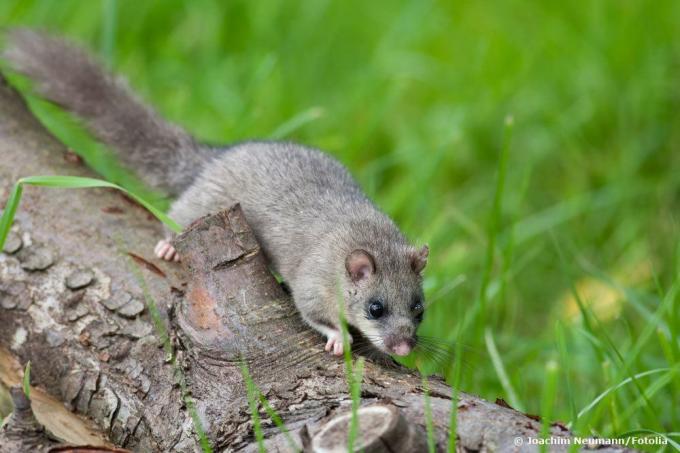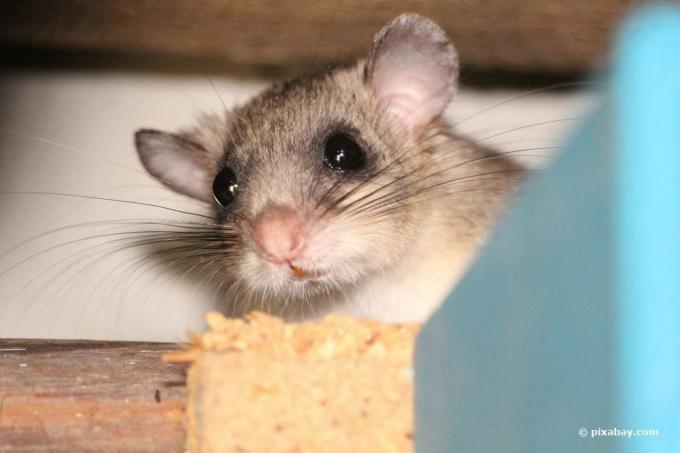
table of contents
- Recognize dormouse
- Appearance
- Sounds
- traces
- Damage
Even if dormice are cute rodents, they can quickly become a real nuisance in the house. If you want to avoid greater damage, you would do well to drive it away. However, they are not allowed to be killed, the animals, which are fundamentally endangered, are protected by species. That is why it is very important to recognize dormice. Confusion with other rodents, which can be fought with poison or with traps, is relatively easy.
Recognize dormouse
The dormouse, whose zoological name is Glis glis, is a rodent that is vaguely reminiscent of a squirrel. Its natural habitat is dense deciduous forests with lots of undergrowth. This undergrowth offers them the protection they need from the cold, wet and predators. The animals usually also build their nests there. To hibernate, they create corridors in the forest floor, in which they stay for about seven months a year. The problem is that the natural habitat of dormouse is shrinking. Among other things, it is threatened by the decade-long trend towards monocultures in our forests. As a result, the animals look for alternative habitats. The excellent climbers often penetrate
Roof trusses of buildings. Almost ideal living conditions await them there. Access is usually through openings in the roof due to the construction. Nests are preferred in the insulation or in the insulation material.Note: Glis glis is no longer acutely threatened with extinction, but it is still under species protection. That is why he must not be killed, but rather must expelled will.
Appearance
As mentioned earlier, dormice have a certain resemblance to squirrels. Its most striking feature is undoubtedly its long, bushy tail. The body itself can best be described as mouse-like. In addition to their tail, they differ from mice mainly through their large, protruding eyes. The body of a dormouse is about twelve to 19 cm long, the tail length is in a range of ten to 15 cm. The fur of the animals is usually gray or gray-brown. It turns yellowish-white on the underside of the body. Who actually gets to see the rodent will usually be able to identify it relatively easily by means of the tail. However, it is much more likely that you will discover traces and residues such as feces or urine. You can usually tell whether you are dormouse by strange noises in the area of the roof structure and by significant damage to the insulation material.
Sounds
In most cases, it is noises that cannot be precisely identified at first, which suggest that a glis glis has nested in the house. These noises can either come from the animals walking around and gnawing or coming directly from them. The rodents communicate with each other by chirping, chirping sounds that can be reminiscent of whistling or squeaking. They utter these sounds up to 100 times in a row. If they are disturbed in their activities or if there is imminent danger, they react with rattling, almost whirring noises, which also serve as a warning for their fellows. Since dormice usually live in groups, the very normal communication between the animals can become a certain annoyance.
traces
The presence of a dormouse in the house is usually shown very quickly by certain traces and legacies. These can come from other rodents such as mice or rats, but they do come into contact with the noise described above, the probability is very high that it is actually a dormouse acts. The following traces and legacies are typical:
- small, black droppings droppings that are scattered all over the place
- strong smelling puddles of urine
- Signs of gnawing on cables and cladding
- gnawed fruit remains
- torn out pieces of insulation
- possibly already decaying snails, eggs or young birds
- heavily gnawed pieces of wood or gnawed beams
- Footprints in the dust
Dormouse have a very pronounced gnawing drive, which is why gnawing marks are relatively common. Paw tracks can be assigned to them very easily because no claws can be seen in the prints. This is what distinguishes them from mice or rats. In addition, both the front paws and the rear paws can always be found next to each other. If there is suddenly a lot of soft material lying around in the attic that is suitable for nest building, this is also a clear indication. The nest itself is usually well hidden and can usually only be found by accident. It is very likely that it is in the insulation layer of the roof.
Note: Exactly which rodent infestation is involved can only be determined by an exterminator or an exterminator. find a certified pest controller. He should actually be called if there is any suspicion, since attempts to get rid of the rodent usually fail.
Damage
With all due understanding for the animals, dormice should definitely be driven away. This is because they can cause considerable damage. For example, the risk of fire increases significantly if power lines are eaten by them. Moisture can penetrate through gnawed roof insulation, which in turn damages the building fabric. A very unpleasant vermin infestation is also possible. The reason for this are decaying animals that the rodents brought in as prey. It is true that dormice clearly prefer fruit and seeds as food. However, they do not disdain snails, insects, eggs or even young birds.


